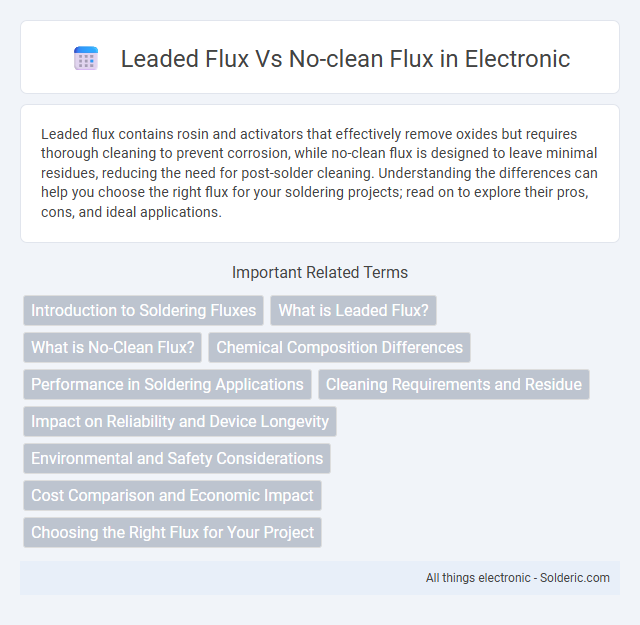Leaded flux contains rosin and activators that effectively remove oxides but requires thorough cleaning to prevent corrosion, while no-clean flux is designed to leave minimal residues, reducing the need for post-solder cleaning. Understanding the differences can help you choose the right flux for your soldering projects; read on to explore their pros, cons, and ideal applications.
Comparison Table
| Feature | Leaded Flux | No-Clean Flux |
|---|---|---|
| Composition | Contains lead-based compounds | Lead-free, contains organic acids or rosins |
| Residue | Corrosive, requires cleaning | Non-corrosive, minimal residue |
| Environmental Impact | Higher toxicity due to lead content | Eco-friendly, compliant with RoHS |
| Cleaning Requirement | Mandatory post-solder cleaning | No cleaning needed in most cases |
| Performance | Excellent wetting, reliable joints | Good wetting, suitable for most applications |
| Health & Safety | Hazardous, requires precautions | Safer for workers |
| Application | Used in legacy and high-reliability electronics | Standard in modern electronics manufacturing |
Introduction to Soldering Fluxes
Soldering fluxes play a crucial role in promoting wetting and preventing oxidation during the soldering process, with leaded flux containing activators designed for lead-based solders and no-clean flux formulated for lead-free applications. Leaded flux typically leaves residues that require cleaning post-soldering, while no-clean flux residues are minimal and often non-corrosive, eliminating the need for extensive cleanup. Your choice between leaded and no-clean flux depends on factors like solder type, residue tolerance, and environmental regulations in electronics manufacturing.
What is Leaded Flux?
Leaded flux is a type of soldering flux containing lead compounds designed to enhance the wetting properties and electrical conductivity during the soldering process. It helps remove oxides from metal surfaces, ensuring strong, reliable solder joints especially in electronics assembly. Your choice of leaded flux can impact both soldering quality and compliance with environmental regulations due to its lead content.
What is No-Clean Flux?
No-clean flux is a type of soldering flux designed to leave minimal residue that is non-corrosive and electrically non-conductive, eliminating the need for post-soldering cleaning. Unlike leaded flux, which often requires thorough cleaning to remove harmful residues, no-clean flux simplifies manufacturing processes while maintaining reliable electrical connections. Your choice of no-clean flux enhances efficiency by reducing cleaning time and minimizing environmental impact in electronics assembly.
Chemical Composition Differences
Leaded flux typically contains rosin or resin-based activators combined with leaded solder particles, enhancing wetting properties and electrical conductivity during soldering. No-clean fluxes are formulated with organic acids and less corrosive agents designed to leave minimal residues that do not require cleaning after the soldering process. Your choice between leaded flux and no-clean flux depends on the need for residue removal, environmental regulations, and the specific chemical composition influencing solder joint quality.
Performance in Soldering Applications
Leaded flux typically offers superior wetting and heat stability, making it highly effective for challenging soldering applications that require precise joint formation. No-clean flux minimizes residue and cleanup, enhancing productivity and reducing contamination risk, though it may occasionally compromise solder joint quality in high-reliability environments. Your choice between leaded and no-clean flux depends on balancing performance needs with environmental and process considerations.
Cleaning Requirements and Residue
Leaded flux typically requires thorough cleaning after soldering to remove corrosive residues that can cause long-term damage or electrical failures. No-clean flux is formulated to leave minimal, non-corrosive residues, often eliminating the need for post-soldering cleaning and simplifying manufacturing processes. Choosing no-clean flux can save time and reduce costs associated with cleaning, but leaded flux remains preferred in high-reliability applications where residue removal ensures optimal circuit performance.
Impact on Reliability and Device Longevity
Leaded flux formulations generally provide superior wetting and oxidation prevention, enhancing solder joint reliability and contributing to longer device lifespan in harsh environments. No-clean flux leaves minimal residue, reducing the need for cleaning and potential residue-related corrosion, but may compromise long-term reliability if residues absorb moisture or contaminants. Selecting flux types depends on application requirements, balancing the improved joint integrity of leaded flux against the maintenance advantages of no-clean variants.
Environmental and Safety Considerations
Leaded flux contains hazardous substances such as lead and halides that pose significant environmental and health risks, requiring careful handling and disposal to prevent soil and water contamination. No-clean fluxes typically have lower toxicity levels and leave minimal residue, reducing the need for post-solder cleaning and lowering environmental impact. Choosing no-clean flux enhances workplace safety by minimizing exposure to harmful chemicals and improving air quality during soldering processes.
Cost Comparison and Economic Impact
Leaded flux generally incurs higher costs due to stricter environmental regulations and disposal requirements, increasing your overall production expenses. No-clean flux reduces economic impact by minimizing cleaning processes, lowering labor and solvent costs while improving throughput. Evaluating total cost of ownership highlights no-clean flux as a more cost-effective solution for long-term manufacturing efficiency.
Choosing the Right Flux for Your Project
Choosing the right flux for your project depends on the specific soldering requirements and environmental considerations. Leaded flux typically offers superior wetting and strong solder joints, making it ideal for precision electronics and high-reliability applications. No-clean flux eliminates the need for post-solder cleaning, reducing assembly time and improving safety, which is beneficial for your production efficiency and environmental compliance.
Leaded flux vs no-clean flux Infographic

 solderic.com
solderic.com